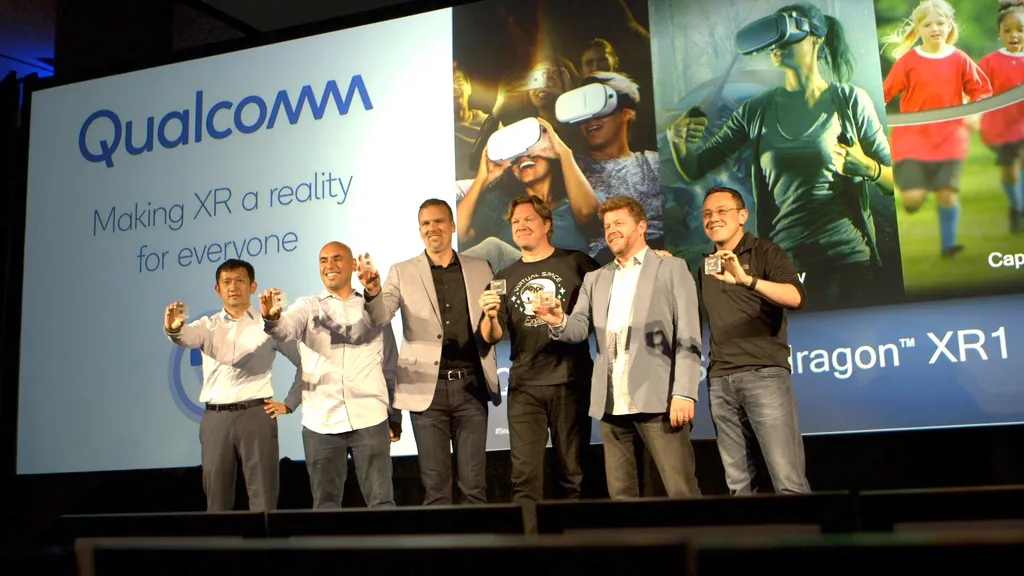There is no doubt that standalone headsets, be they for AR or VR, are starting to pick up some steam. This momentum is especially noticeable with headsets like the ODG R9, HTC Vive Focus, Lenovo Mirage Solo and the Oculus Go. Smartphone designs like Gear VR and Daydream are fundamentally incompatible with long-term VR usage. Now that we have standalone VR headsets and the market is starting to heat up it only seems logical that we would finally start to see XR-specific components. One of the most expensive components in an XR headset is also one of the most important parts of the headset, the SoC (system on chip) which does nearly all the device’s processing.
Qualcomm’s smartphone chips that are powering nearly all the standalone XR headsets today are repurposed for XR uses. Because Qualcomm’s chips are designed to be very low-power and high-performance, especially on graphics, they are uniquely suited to power standalone XR headsets. However, there are certain aspects of the smartphone design cycle and SoC design that aren’t optimized for XR. As a result, the cost of using a Snapdragon smartphone chip is higher than it needs to be since not all the components of the smartphone SoC are being used. By building an optimized chip for use in XR headsets, Qualcomm is enabling their many partners in the XR ecosystem to be able to build higher quality devices with more features at lower cost.
That gets us to the Snapdragon XR1, Qualcomm’s first and the industry’s first built-for-XR SoC to power a standalone headset. The XR1 is the first in what I expect to be a series of XR-specific SoCs targeted at satisfying the needs of headset manufacturers and the developers that build applications for them. However, the XR1 is not the pinnacle of VR or even mobile VR for that matter; the XR1 is designed to hit the segment of the market that delivers a high-quality VR experience at an affordable price. This isn’t quite the same as the premium quality devices that feature the company’s fastest and most expensive SoCs (Snapdragon 835 and 845). While there is no defined price point that the XR1 is trying to hit because of the flexibility of being an XR-capable chip, I expect that the XR1 will deliver a good experience regardless of the device…but with limitations.
These more mainstream XR1-based devices would fit more into the Oculus Go category of devices. They could have 3-DoF tracking and relatively simply point and click controllers like the Oculus Go or 6-DoF tracking and 6-DoF controllers, at a cost. In fact, one could almost see the XR1 as the chip that will enable VR manufacturers to be competitive with Facebook and Oculus on the Oculus Go while still being within reach regarding price. Before today’s announcement, the Snapdragon 845 was the only SoC that Qualcomm offered for XR that could offer 6-DoF head tracking and 6-DoF controllers. With the introduction of the XR1, we could see the democratization of 6-DoF head tracking and controllers at an even lower price point, driving up the need to support such features for developers and giving a unified user interaction environment for developers.
Companies like Meta, Pico, HTC Vive and Vuzix have already committed to using the XR1, which means we could see some very interesting mobile VR and AR headsets from these companies very soon. This already shows a significant commitment from some of the biggest players in the space to adopt this platform and give it credibility as a solution for the industry. Looking forward, I believe that the XR1 will help to mark a point where the industry stopped repurposing smartphone components for use in XR headsets and finally started to use purpose-built components that elevate the user experience. I believe these improvements will still come at a premium, but with chips like the XR1 democratizing 6-DoF tracking and headsets, I believe that we will start to have a certain set of features that are considered standard across the industry. We’re starting to get there slowly, but I think XR1 and 6-DoF head and controller tracking will start to pave the way for 6-DoF eventually being the standard for everyone that wants to consider their solution competitive.
We can still very likely expect a Snapdragon 855 or something later this year from Qualcomm that will probably still find its way into high-end XR headsets. However, I believe as volumes increase we could see an XR2 or XR3 that are, like the XR1, specifically catered to enabling the best XR experience at the best price. Until then, we’ll have our continuum of Qualcomm Snapdragon chips ranging from the Snapdragon XR1 to the Snapdragon 845 and all the chips in between. There are no specifics on when we can see devices based on the XR1 from the OEMs above, but if history is any indicator, they will all launch at different times and probably at very different prices.
Disclosure: My firm, Moor Insights & Strategy, like all research and analyst firms, provides or has provided research, analysis, advising, and/or consulting to many high-tech companies in the industry including Qualcomm and others. I do not hold any equity positions with any companies cited.




























